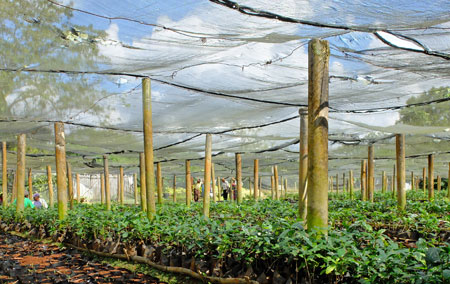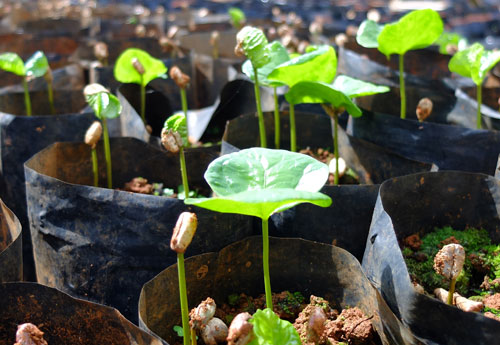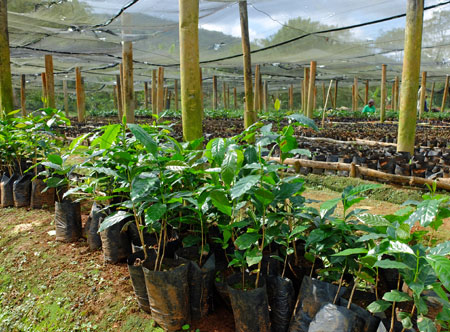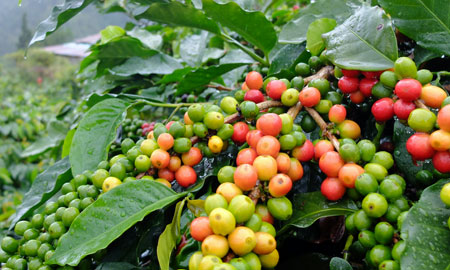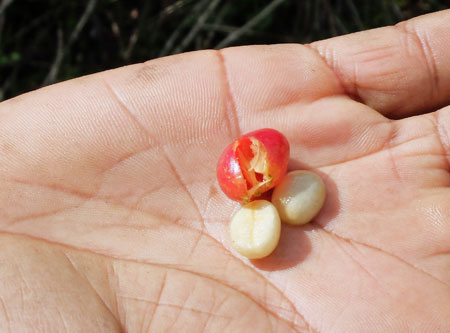Jamaica Blue Mountain Coffee – from seed to harvest.
When I was in Jamaica earlier this year I followed the complete coffee growing and processing journey…from the seed right through to the roasted, packaged product.
And, as you’ll see, I took plenty of photos.
In this article I’ll share the first half of that journey…from the moment a coffee seed is planted, right through to the moment of harvest.
It’s easy to forget that the coffee bean we see in the supermarket is actually a seed. And if you haven’t spent much time in a coffee-growing region of the world, you might assume that coffee trees grow naturally in the wild.
But coffee is not indigenous to Jamaica, nor to most other countries that grow coffee.
Coffee first came to the Caribbean in 1738, and the first mention of coffee being grown in the Blue Mountains of Jamaica was in 1834.
In other words, if you want to grow and harvest coffee, you have to plant seedlings. Where do those seedlings come from? From farms that specialize in raising coffee trees from the seed to a young tree that is ready to be replanted on a plantation.
The beans are planted in pots and left to germinate.
In the photo above the seedlings are about 3 weeks old. You can still see the remains of the coffee bean still attached to some of the plants.
And as you can see from the first photo on this page, the plants are grown under a semi-transparent canopy that approximates “partial shade” in the wild. This canopy protects the young plants from harsh, direct sunlight.
The farm I was visiting grows about 50,000 seedlings a year, some of which are then planted on their own plantation. But most are then sold to other coffee growers on the island.
In other words, this is where many of the island’s coffee trees get their start.
After 10 months the coffee trees are ready to be transplanted.
The trees in the photo above are at the 10-month stage, and ready to be replanted on a coffee plantation somewhere on the island.
It will be 3 more years before they produce any berries and 5 years before they are in full production.
During this period they have to be well cared for. Weeds need to be cut back, pests like the coffee borer beetle have to be kept at bay, and a sharp eye has to be kept on any infestations of the coffee rust fungus.
In other words, coffee farmers have to take great care of the plants for several years before they can expect to harvest any beans from the young trees.
This is a big investment in time and effort, particularly on the steep mountain slopes where Jamaica Blue Mountain coffee is grown.
Finally, the coffee cherries are ready to be picked.
Coffee cherries on the same tree ripen at different times.
In some coffee-growing countries, particularly on large farms on flat ground, the farmers compromise and harvest the cherries all at once.
This pretty much guarantees a compromised crop and an overall lowering of quality.
In Jamaica the cherries are picked by hand, and on each pass only the ripe cherries are picked. This can triple the work involved in harvesting the coffee, or more. But the result is a much higher quality in the final product.
Once picked, each cherry contains two seeds, or coffee beans.
The cherry is soft, and it’s easy to break it open and find the coffee beans inside.
The pulp of the cherry is actually quite tasty. I tried one myself and enjoyed it. Unfortunately, nobody has yet found a bulk use for this pulp, so it is composted and then returned to the ground around the coffee trees.
The two beans you see in the photo above are not yet the “green coffee beans” used for roasting. There are several more steps in the process.
These beans, fresh from the cherry, are known as “wet parchment” and are about 45% water.
In my next article I’ll take you through the next steps on the process, of which there are several.
In the meantime, I hope this article has given you an idea of just how much work and care goes into getting the coffee from the seedling to your cup.
Other articles in this series:
My visit to Jamaica’s Blue Mountain Coffee region.
Why Jamaica’s Blue Mountain Coffee is so good, and why it costs more.
Processing coffee in Jamaica’s Blue Mountains.
How low-tech and high-touch makes Jamaica Blue Mountain Coffee so good.
NOTE: My visit to the Blue Mountain Coffee region wouldn’t have been possible without the generosity and hospitality of David and Marlene of SimpleIndustries.ca (where you can buy Blue Mountain Coffee), and the expert guidance of Basil Jones of Coffee Solutions Ltd. Thank you!
All photos and text © copyright Nick Usborne.
About the author: Nick Usborne, aka Coffee Detective, is a writer and long-time coffee enthusiast. Read more…
Before you go, sign up to receive the Coffee Detective Newsletter...
Sign up for occasional newsletters about the best coffees and brewing equipment. Plus special updates from the Coffee Detective Coffee Store…
